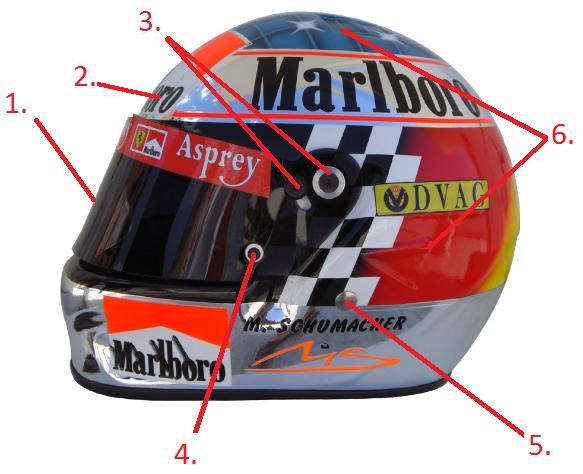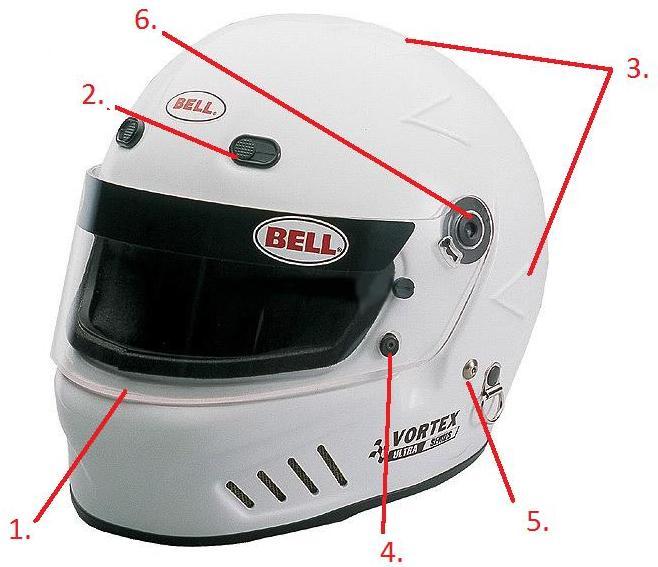|
|
|
|
|||||||
|
|
|||||||||
|
|
- Helmet buying guide -
Over the last decade there has been an influx of unlicensed, fake, poor quality, imitation non safety device helmets flooding the market from South American and Asia. If you are new to collecting helmets this guide may save you a lot of money and heartache in the future, as many unknowing buyers believe these to be collectables. I will start by grading the helmets in value
(which is governed by rarity and demand) to put the fake helmets into context. 1- Race used helmet. Generally about 12 helmets
are used per driver per season these days. Previously, mid nineties
through to 2004 this would have have been about 24 helmets per season.
However the introduction of the very expensive Carbon (£3000+ unpainted)
helmets has reduced this number. Prior to the mid nineties the drivers
used considerably less helmets per year. Anything from 4-8 per season in
the seventies and eighties. (Pictured: A race prepared Michael Schumacher 1997 BELL helmet)
Replica helmets
(Pictured: A M. Schumacher 1996 official replica.
An edition of 100 in the familiar BELL SPORTS case)
(Pictured: A Eddie Irvine 1996 official replica. A large limited edition by Bieffe)
All of the above are official helmets, produced under license. This adds to their value. The next types of replica are not official. The first type is accepted by most in the collecting community if done to a high standard. In fact many collectors prefer these helmets because sometimes official helmets aren't wearable.
6- Non official replica on a imitation helmet "south american helmets". Somebody somewhere decided to buy a genuine helmet, lets say a BELL VORTEX, and make an illegal copy of it. They took the genuine helmet and used it to create a mould from which they are now making thousands of illegal copies that do not conform to any type of safety regulation and not accurate to the genuine helmet. They then add a generally poor paint job and sell them as collectable replica F1 driver helmets. The companies that produce these fake helmets now have a fake copy of all of the most commonly used F1 helmets over the past three decades. These are mass produced (thousands per helmet) with mainly stickers and poor paintwork. Arai, BELL and all the other major manufacturers have been trying to shut the factories that produce these down for over a decade now. Both companies have realeased warnings about buying and using these counterfeit helmets. The helmet manufacturers and F1 teams have had numerous websites that sell these fake replica driver helmets down. But as one is closed another opens within days. They have flooded the market and some buyers do not know the difference between an official BELL helmet and one of these helmets. One is $4000, the other $400. So when they see a fake helmet for a 1/8th of the price of the official one they think they have a bargain. Where in reality the official replica BELL helmet that will have an edition size of 30-100 is a collectable painted by the original artist and hand signed by the driver will more than likely keep its value if not go up. The fake helmet, as more and more flood the market will only go down in value. They have been flooding the market with these for over 15 years now. These are usually found on ebay from Chinese and South American sellers. Most dealers do not deal in these for obvious reasons, but there are one or two exceptions. The big problem here is that these questionable helmets are sold alongside beautiful race used and official replica helmets. How is a customer to know what is a the excellent official collcetible helmet and what is otherwise? Basically, thousands of people have not realised until they tried to sell the helmet. Its very tough to tell if you don't know much about helmets. I fell for it about 15 years ago when they first came out. These are examples of the questionable helmets helmets currently available online. Lewis Hamilton; Seb Vettel; Nikki Lauda; If you are unsure if a helmet is a South American fake then ask the vendor directly if this is the case. Ask what snell rating the helmets has. How to spot a fake helmet? Lets use the example of a Schumacher 1998 Chrome helmet, this particular one created on a 'fake' BELL Vortex. Fake helmet
Plain white proper BELL VORTEX
1. The visor is thin and flimsy, unlike the 3mm bullet proof one on the proper Bell helmet. As of 2010, the fakes also never have tear off holders on the visor (black knob). 2. The proper helmet has air vents on the top. 3. Due to the moulding technique the detailing isn't as prominent as the proper helmet. As detail is lost when you mould. The is evident on all fake helmets and the give away that they have moulded proper helmets. A mould has to have exaggerated detailing to produce the desired effect, as some detailing is always lost with the moulding technique. 4. Visor catch is often silver on fakes, it should be black. 5. The stud on the side (that holds the straps in place) is often a flat piece of metal. On a BELL helmet this will always be a star shaped screw stud. 6. The visor pivot is also completely different. On this particular model it is one scew, where as the forgers have used 2. That is a basic way to spot a fake helmet. The interiors, straps, poor paint finishes, design inaccuracies, lack of snell labels and flimsiness of the helmets are also tell tale signs. |
+ + +
|
||||||
|
sales@racefan.co.uk |
|||||||||
|
|
|||||||||
|
|
|||||||||


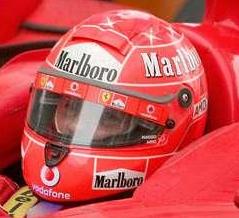 (Pictured: Michael Schumacher winning the Chinese GP 2006)
(Pictured: Michael Schumacher winning the Chinese GP 2006)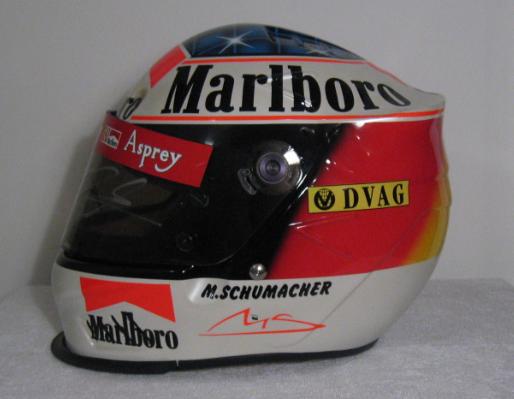
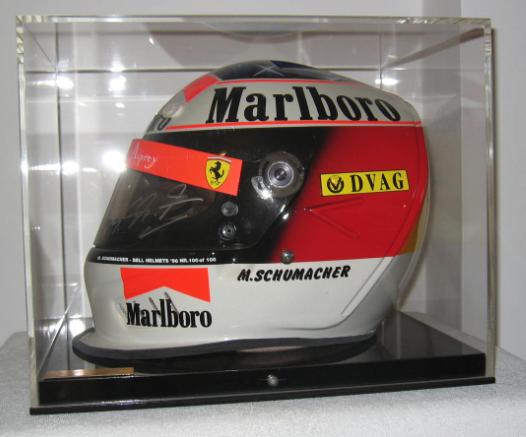 3-
Official
strictly limited edition replicas.
Usually very exclusive and only about 10-100 made for each helmet.
These will usually be on a proper race specification (if Arai) or in a
display case if BELL. After these are given to sponsors and friends of
drivers very few make the market place. They are rare and painted
by the same people who paint the drivers original in most cases. These
can also include "promotional helmets" that are produced for the teams
and sponsors but never available for public sale.
3-
Official
strictly limited edition replicas.
Usually very exclusive and only about 10-100 made for each helmet.
These will usually be on a proper race specification (if Arai) or in a
display case if BELL. After these are given to sponsors and friends of
drivers very few make the market place. They are rare and painted
by the same people who paint the drivers original in most cases. These
can also include "promotional helmets" that are produced for the teams
and sponsors but never available for public sale.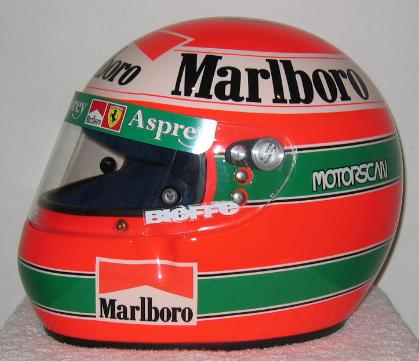 4-
Large edition replicas. These are as above but in higher numb
4-
Large edition replicas. These are as above but in higher numb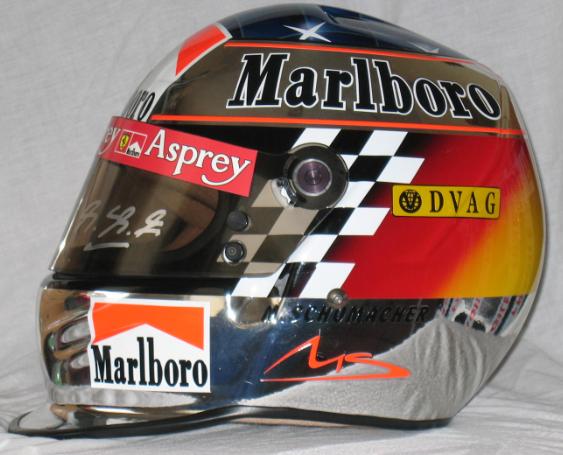 5-
A non official replica that has been done to a very high standard
(i.e. perfect) on a proper helmet, (Snell rated) the same as that used by
the driver in question. The painter can be anybody, ranging from people
who actually paint for companies like BELL and Arai whom paint their own
helmets in their spare time making them perfect replicas without
official recognition, down to a guy doing them in his garage. At Racefan we are fortunate to have a
host of current and past F1 and Indycar artists painting such helmets
for our collection.
5-
A non official replica that has been done to a very high standard
(i.e. perfect) on a proper helmet, (Snell rated) the same as that used by
the driver in question. The painter can be anybody, ranging from people
who actually paint for companies like BELL and Arai whom paint their own
helmets in their spare time making them perfect replicas without
official recognition, down to a guy doing them in his garage. At Racefan we are fortunate to have a
host of current and past F1 and Indycar artists painting such helmets
for our collection.